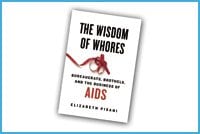After nearly a decade of tracking HIV-infection patterns among high-risk groups in Asia, Elizabeth Pisani has concluded that there’s a worldwide shortage of frank discussion about HIV risk factors. People, she says, don’t talk openly about “sex and drugs and all the other daft things you do when you’re thinking with your dick, or female equivalent.”
The Wisdom of Whores describes in almost comic detail how the US government doles out billions of dollars to fund abstinence before marriage programs that don’t work and to “eradicate prostitution” in countries where there are few alternatives. This approach is tainted by religious ideology — the kind of bible-thumping that paints AIDS as an angry and vengeful God’s punishment of gays. According to Pisani political correctness, human rights and money — especially money — also conspire to distract attention from the realities of the world AIDS crisis.
“It’s recognized that there’s an institutional investment in making HIV absolutely everybody’s problem, in making it a development issue and a gender inequality issue and in mounting an expansive multisectoral response and all of that bollocks,” Pisani explains. “But while we’re doing that we’re refocusing prevention away from what works.”
A former Asian correspondent for Reuters, Pisani stumbled into the world of epidemiology after returning to school in the UK in the mid 1990s. With a PhD in infectious disease epidemiology she joined the newly formed United Nations umbrella group UNAIDS in 1996 and helped to sound the alarm about the rapidly growing numbers of HIV cases.
She relates with frustration how world leaders are afraid to confront evidence that intergenerational and extramarital sex — sex that lies outside the bounds of polite conversation — fuel HIV transmission in parts of Africa. They prefer, she says, to portray AIDS as an issue of poverty and under-development. But Uganda and Senegal, despite their socioeconomic challenges, were able to stave off the worst of the HIV epidemic by focusing prevention efforts on sex workers and people having “sex in nets,” or with multiple partners.
Elsewhere the timidity had disastrous consequences: By the time Pisani penned the first biennial report on AIDS in 1998 one in four adults in some African countries were believed to be infected.
“I just reached a pitch of frustration that we could be making so much more difference than we were,” she says.
The late Republican senator Jesse Helms told the New York Times in 1995 that he wanted to decrease funding for US domestic AIDS programs because the disease was spread by the “deliberate, disgusting, revolting conduct” of gays.
It was then that the “AIDS industry” — Pisani’s term for the many national governments, NGOs, faith groups, pharmaceutical companies and do-gooder rock stars — finally got on board. Helms changed his tune in 2000 when celebrities like Bono and Franklin Graham, son of evangelist Billy Graham, convinced him that HIV brings immeasurable suffering “to infants and children and their families.” Helms was one of the driving forces behind the 2003 President’s Emergency Plan for AIDS Relief (PEPFAR), a five-year, $15-billion US program to fight the epidemic.
PEPFAR did raise the bar for funding HIV programs in developing countries but, Pisani points out, the same people who are silent about HIV as it rampages among gay men, drug users and sex workers in the West are also squeamish about helping gay men, drug users and sex workers in the rest of the world.
Faith-based groups are singled out for special treatment under PEPFAR, despite the opposition of many churches to contraception and homosexuality. Only 20 percent of PEPFAR funds goes to prevention efforts and fully a third of that money promotes abstinence — an approach that doesn’t work — as the sole means of prevention.
High-risk groups have been entirely overlooked. By law, donor recipients aren’t allowed to take PEPFAR funds if they intend to help sex workers do anything but get out of the business. Brazil, which wants to regulate sex work, walked away from $40 million rather than yield to this demand. And to this day not a cent has gone toward harm-reduction programs for drug users, Pisani notes.
There are also those who see PEPFAR as an investment rather than an act of mercy. In the first years of the project huge amounts of cash went toward buying brand name antiretroviral drugs and “Made in America” condoms rather than relying on cheaper, local versions.
In Asia, where Pisani started tracking HIV-prevalence rates in 2001, close to 100 million people were being ignored or underserviced. It was her job to figure out in which circles HIV was being spread, mainly through good old-fashioned field surveillance: sample some people and ask them about their behaviours. Pisani found that asking transgendered sex workers about condom negotiation and learning the street value of heroin in Jakarta turned out to be a lot like writing a good news story.
“I never thought I would be an arms-length number cruncher,” Pisani says. “I was first and foremost a journalist and that means talking to people.”
Those people include Fuad, a young Indonesian long-haul truck driver who supplements his meagre income by selling sex to men, as does his girlfriend back home. Pisani spoke with Frankie, a former heroin user from Bali who used to share a single needle among dozens of his fellow inmates in prison. Pisani learned that in Indonesian jails heroin is cheaper than clean needles.
We meet Nancy, who is at ease talking about her work as the headmistress of an Indonesian network of MTF transsexual sex workers known as waria. She complains that her young charges have no respect for their elders, brazenly showing off their designer vaginas — bought at sex-change clinics in neighbouring Thailand — to potential clients. Nancy also works for Jakarta’s Department of Social Affairs teaching waria the practical skills they need for career options outside of sex work. But even in the face of high HIV- prevalence rates and a conservative Muslim theology that vilifies sex work and condom use, most waria remain sex workers either because the pay is too good or it’s the only job they’ve ever known. They choose.
“It’s less about the money than about the orgasms,” Nancy explains to Pisani. “Let’s face it, we’re all human, we’ve all got to get laid.”
The book is full of such frank, often funny revelations from ordinary people. Combined with reams of statistical data collected from the red-light districts of Jakarta to the gay discos of Shanghai, Pisani comes to a simple but inescapable conclusion: sometimes people, for survival, fun or a combination of the two, take risks and they need help to do so more safely, not preaching and isolation.
But Pisani is not just another angry scientist railing against conservative values. She also tears a strip off liberal activists who have their own grab bag of failed policies, what she calls “the sacred cows of the AIDS industry.”
Many of the ideas central to prevention today, such as emphasizing peer education, using grassroots non-governmental organizations for outreach and pressing for a strict “voluntary testing only” rule, were borrowed from the playbooks of AIDS activists in gay communities in the ’80s.
They were amazingly successful under the repressive conditions they faced but, according to Pisani, many of the underlying assumptions change when you go halfway around the world. Peer education? Pisani says sex workers and drug users are more often rivals than friends, that small-scale outreach falls apart when your client base is too large or spread over too large an area, and that in some cases mandatory testing can break the wall of shame and stigma when followed up with care and support services.
Pisani also unabashedly tears apart any notion that it’s preferable to spend money on universal prevention campaigns rather than target high-risk behaviours. She blames this mentality on the politicization of the issue — the back-and-forth between ideologies that has hindered epidemiologists’ efforts to treat HIV like any other infectious disease.
“That’s what it is, first and foremost,” she says. “But now we’re in this weird situation where saying ‘HIV is a gay disease’ is stigmatizing to the gay community. So we say something else. Then awareness and condom use during anal sex drops and suddenly, HIV is a gay disease again…. If, in bending over backward to avoid stigmatizing people, you lose the ability to reach them it won’t work.”
It all sounds rather unkind. Then again public health has always been a rather fascistic discipline, Pisani concedes. When behaviours prove frustratingly hard to change, sometimes you just need to fall back on the basics: condoms, clean needles and frank discussions about the risk factors for HIV transmission.
“Everyone takes risks,” she says. “It’s part of the human condition, thank God; how boring would life be if it weren’t? But people choose the risks they’re willing to take based upon a fairly complex cost/benefit model. It’s not perfect but the more information we give them the more sophisticated their analysis will be.”
Have her experiences made Pisani any more risk-averse? She laughs. “Oh God, no. I’m just as much of a slut as I ever was.”


 Why you can trust Xtra
Why you can trust Xtra


